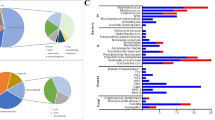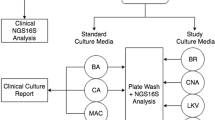Abstract
Spontaneous bacterial peritonitis (SBP) is a severe complication of liver disease. A significant proportion of patients have culture-negative ascites, despite having similar signs, symptoms and mortality to those with SBP. Therefore, empirical antibiotic treatment for infection is often started without knowledge of the causative organisms. Here, we investigated the potential of molecular techniques to provide rapid and accurate characterisation of the bacteria present in ascitic fluid. Ascites samples were obtained from 29 cirrhotic patients undergoing clinically indicated therapeutic paracentesis. Bacterial content was determined by terminal restriction fragment length polymorphism (T-RFLP) analysis, quantitative polymerase chain reaction (PCR) and 16S ribosomal clone sequence analysis. Bacterial signal was detected in all samples, compared to three out of ten using standard methods. Bacterial loads ranged from 5.5 × 102 to 5.4 × 107 cfu/ml, with a mean value of 1.9 × 106 cfu/ml (standard deviation ± 9.6 × 106 cfu/ml). In all but one instance, bacterial species identified by culture were also confirmed by molecular analyses. Preliminary data presented here suggests that culture-independent, molecular analyses could provide rapid characterisation of the bacterial content of ascites fluid, providing a basis for the investigation of SBP development and allowing early and targeted antibiotic intervention.

Similar content being viewed by others
References
Sort P, Navasa M, Arroyo V, Aldeguer X, Planas R, Ruiz-del-Arbol L, Castells L, Vargas V, Soriano G, Guevara M, Ginès P, Rodés J (1999) Effect of intravenous albumin on renal impairment and mortality in patients with cirrhosis and spontaneous bacterial peritonitis. N Engl J Med 341:403–409
Guarner C, Solà R, Soriano G, Andreu M, Novella MT, Vila MC, Sàbat M, Coll S, Ortiz J, Gómez C, Balanzó J (1999) Risk of a first community-acquired spontaneous bacterial peritonitis in cirrhotics with low ascitic fluid protein levels. Gastroenterology 117:414–419
Thuluvath PJ, Morss S, Thompson R (2001) Spontaneous bacterial peritonitis—in-hospital mortality, predictors of survival, and health care costs from 1988 to 1998. Am J Gastroenterol 96:1232–1236
Llovet JM, Moitinho E, Sala M, Bataller R, Rodríguez-Iglesias P, Castells A, Fernández J, Planas R, Navasa M, Bruix J, Rodés J (2000) Prevalence and prognostic value of hepatocellular carcinoma in cirrhotic patients presenting with spontaneous bacterial peritonitis. J Hepatol 33:423–429
Park YH, Lee HC, Song HG, Jung S, Ryu SH, Shin JW, Chung YH, Lee YS, Suh DJ (2003) Recent increase in antibiotic-resistant microorganisms in patients with spontaneous bacterial peritonitis adversely affects the clinical outcome in Korea. J Gastroenterol Hepatol 18:927–933
Cheong HS, Kang CI, Lee JA, Moon SY, Joung MK, Chung DR, Koh KC, Lee NY, Song JH, Peck KR (2009) Clinical significance and outcome of nosocomial acquisition of spontaneous bacterial peritonitis in patients with liver cirrhosis. Clin Infect Dis 48:1230–1236
Runyon BA (2003) The evolution of ascitic fluid analysis in the diagnosis of spontaneous bacterial peritonitis. Am J Gastroenterol 98:1675–1677
Koulaouzidis A, Bhat S, Karagiannidis A, Tan WC, Linaker BD (2007) Spontaneous bacterial peritonitis. Postgrad Med J 83:379–383
García-Tsao G (1992) Spontaneous bacterial peritonitis. Gastroenterol Clin North Am 21:257–275
Arroyo V, Jiménez W (2000) Complications of cirrhosis. II. Renal and circulatory dysfunction. Lights and shadows in an important clinical problem. J Hepatol 32:157–170
Runyon BA; AASLD Practice Guidelines Committee (2009) Management of adult patients with ascites due to cirrhosis: an update. Hepatology 49:2087–2107
Rimola A, García-Tsao G, Navasa M, Piddock LJ, Planas R, Bernard B, Inadomi JM (2000) Diagnosis, treatment and prophylaxis of spontaneous bacterial peritonitis: a consensus document. International Ascites Club. J Hepatol 32:142–153
Runyon BA, Hoefs JC (1984) Culture-negative neutrocytic ascites: a variant of spontaneous bacterial peritonitis. Hepatology 4:1209–1211
Terg R, Levi D, Lopez P, Rafaelli C, Rojter S, Abecasis R, Villamil F, Aziz H, Podesta A (1992) Analysis of clinical course and prognosis of culture-positive spontaneous bacterial peritonitis and neutrocytic ascites. Evidence of the same disease. Dig Dis Sci 37:1499–1504
Pelletier G, Salmon D, Ink O, Hannoun S, Attali P, Buffet C, Etienne JP (1990) Culture-negative neutrocytic ascites: a less severe variant of spontaneous bacterial peritonitis. J Hepatol 10:327–331
Rogers GB, Carroll MP, Bruce KD (2009) Studying bacterial infections through culture-independent approaches. J Med Microbiol 58:1401–1418
Rogers GB, Daniels TWV, Tuck A, Carroll MP, Connett GJ, David GJ, Bruce KD (2009) Studying bacteria in respiratory specimens by using conventional and molecular microbiological approaches. BMC Pulm Med 9:14
Harris KA, Hartley JC (2003) Development of broad-range 16S rDNA PCR for use in the routine diagnostic clinical microbiology service. J Med Microbiol 52:685–691
Whelen AC, Persing DH (1996) The role of nucleic acid amplification and detection in the clinical microbiology laboratory. Annu Rev Microbiol 50:349–373
Espy MJ, Uhl JR, Sloan LM, Buckwalter SP, Jones MF, Vetter EA, Yao JD, Wengenack NL, Rosenblatt JE, Cockerill FR 3rd, Smith TF (2006) Real-time PCR in clinical microbiology: applications for routine laboratory testing. Clin Microbiol Rev 19:165–256
Rogers GB, Carroll MP, Serisier DJ, Hockey PM, Jones G, Bruce KD (2004) Characterization of bacterial community diversity in cystic fibrosis lung infections by use of 16s ribosomal DNA terminal restriction fragment length polymorphism profiling. J Clin Microbiol 42:5176–5183
Nadkarni MA, Martin FE, Jacques NA, Hunter N (2002) Determination of bacterial load by real-time PCR using a broad-range (universal) probe and primers set. Microbiology 148:257–266
Such J, Francés R, Muñoz C, Zapater P, Casellas JA, Cifuentes A, Rodríguez-Valera F, Pascual S, Sola-Vera J, Carnicer F, Uceda F, Palazón JM, Pérez-Mateo M (2002) Detection and identification of bacterial DNA in patients with cirrhosis and culture-negative, nonneutrocytic ascites. Hepatology 36:135–141
Francés R, Benlloch S, Zapater P, González JM, Lozano B, Muñoz C, Pascual S, Casellas JA, Uceda F, Palazón JM, Carnicer F, Pérez-Mateo M, Such J (2004) A sequential study of serum bacterial DNA in patients with advanced cirrhosis and ascites. Hepatology 39:484–491
El-Naggar MM, Khalil ESAM, El-Daker MAM, Salama MF (2008) Bacterial DNA and its consequences in patients with cirrhosis and culture-negative, non-neutrocytic ascites. J Med Microbiol 57:1533–1538
Christensen JE, Reynolds CE, Shukla SK, Reed KD (2004) Rapid molecular diagnosis of lactobacillus bacteremia by terminal restriction fragment length polymorphism analysis of the 16S rRNA gene. Clin Med Res 2:37–45
Dicksved J, Lindberg M, Rosenquist M, Enroth H, Jansson JK, Engstrand L (2009) Molecular characterization of the stomach microbiota in patients with gastric cancer and in controls. J Med Microbiol 58:509–516
Justesen US, Holt HM, Thiesson HC, Blom J, Nielsen XC, Dargis R, Kemp M, Christensen JJ (2007) Report of the first human case of Caulobacter sp. infection. J Clin Microbiol 45:1366–1369
Runyon BA (1990) Monomicrobial nonneutrocytic bacterascites: a variant of spontaneous bacterial peritonitis. Hepatology 12:710–715
Rimola A, Salmerón JM, Clemente G, Rodrigo L, Obrador A, Miranda ML, Guarner C, Planas R, Solá R, Vargas V (1995) Two different dosages of cefotaxime in the treatment of spontaneous bacterial peritonitis in cirrhosis: results of a prospective, randomized, multicenter study. Hepatology 21:674–679
Toledo C, Salmerón JM, Rimola A, Navasa M, Arroyo V, Llach J, Ginès A, Ginès P, Rodés J (1993) Spontaneous bacterial peritonitis in cirrhosis: predictive factors of infection resolution and survival in patients treated with cefotaxime. Hepatology 17:251–257
Author information
Authors and Affiliations
Corresponding author
Rights and permissions
About this article
Cite this article
Rogers, G.B., Russell, L.E., Preston, P.G. et al. Characterisation of bacteria in ascites—reporting the potential of culture-independent, molecular analysis. Eur J Clin Microbiol Infect Dis 29, 533–541 (2010). https://doi.org/10.1007/s10096-010-0891-5
Received:
Accepted:
Published:
Issue Date:
DOI: https://doi.org/10.1007/s10096-010-0891-5




